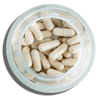Omega-3s are essential for your brain, heart, and overall health, but most people don't get enough. Here's what you need to know:
- Daily Dosage: For general health, aim for 250–500 mg of EPA and DHA. For specific conditions like heart health or inflammation, doses can go up to 4,000 mg daily.
- Best Timing: Take omega-3s with meals containing healthy fats (like avocado or olive oil) for better absorption. Splitting doses can help if you experience side effects.
- Sources: Fatty fish like salmon and supplements are the best sources. Plant-based ALA (from flaxseeds or walnuts) is less effective since your body converts only a small amount to EPA and DHA.
- Special Needs: Pregnant women need 200–300 mg of DHA daily, while children and seniors have specific requirements based on age.
Pro Tip: Choose high-quality supplements with third-party testing to avoid oxidation and ensure accurate labeling.
This guide covers everything, from dosage recommendations to choosing the right supplements, so you can maximize the benefits of omega-3s. Let’s dive in!
Omega-3 Intake: Sources, Dosage & Timing | Dr Bill Harris Ep 3
What Are Omega-3 Fatty Acids
Omega-3 fatty acids are a type of polyunsaturated fat that your body needs to function properly but can't produce on its own. These fats are essential for building healthy cells and play a crucial role in supporting your brain, heart, and eye health. While all omega-3s contribute to overall well-being, they vary in their structure and specific benefits, which makes understanding them key to making smarter dietary choices.
"Omega-3 fatty acids are 'healthy fats' that may support your heart health. One key benefit is helping to lower your triglycerides." - Cleveland Clinic [1]
Unfortunately, most Americans fall short in their omega-3 intake. On average, adults in the U.S. consume only about 0.1 gram of EPA and DHA per day [7], far below the recommended levels for optimal health. This gap highlights the importance of understanding how to incorporate these fats into your diet and sets the stage for the dosing recommendations covered later in this guide.
3 Types of Omega-3: ALA, EPA, and DHA
To get a clearer picture of omega-3s, it’s helpful to break them down into their three main forms: ALA, EPA, and DHA.
ALA (Alpha-Linolenic Acid)
ALA is the most common omega-3 found in the typical American diet. It comes from plant-based sources like flaxseeds, chia seeds, walnuts, and canola oil. The National Academy of Medicine suggests men aim for 1.6 grams of ALA daily, while women should target 1.1 grams [7]. While ALA is essential, its primary role is providing energy, and it doesn’t deliver the specialized benefits associated with EPA and DHA.
EPA (Eicosapentaenoic Acid)
EPA is primarily found in marine-based foods such as fatty fish, algae, and grass-fed animal products. Its standout function lies in producing eicosanoids - compounds that help reduce inflammation [6]. This makes EPA especially important for heart health and managing inflammatory conditions.
DHA (Docosahexaenoic Acid)
Like EPA, DHA is also sourced from marine foods. However, DHA has a unique role as a structural component of cell membranes, particularly in the brain, eyes, and skin [6]. It’s vital for brain development and cognitive function, which is why it’s often recommended during pregnancy and later in life to support mental health and vision.
How Omega-3s Work in Your Body
Each type of omega-3 works differently in your body. While ALA is technically an omega-3, it needs to be converted into EPA and DHA to provide the health benefits typically associated with these fats.
Here’s the catch: your body isn’t very efficient at this conversion. On average, only 1–10% of ALA is converted into EPA, and just 0.5–5% into DHA. Interestingly, women tend to have slightly higher conversion rates due to the effects of estrogen [6][9].
This low conversion efficiency is why EPA and DHA are considered more active and beneficial than ALA [10]. When consumed directly, EPA and DHA are easily absorbed into cell membranes, where they help maintain cellular flexibility and regulate gene activity [9]. EPA, for instance, produces eicosanoids that are less inflammatory and less likely to cause blood vessel constriction or clotting compared to those derived from arachidonic acid [9]. Meanwhile, DHA is particularly effective in reducing certain inflammatory markers and improving blood lipid levels [8], making it essential for brain and eye health.
These differences in how omega-3s are processed and utilized highlight the importance of including EPA and DHA directly in your diet. This foundation will guide the dosage recommendations discussed in the next section.
Science-Based Omega-3 Dosage Guidelines
The right amount of omega-3s depends on your health goals, age, and specific needs. Decades of research have helped clarify these dosage recommendations, making it easier to tailor your intake for optimal results.
"For the average person, taking dietary supplements is really correcting the nearly absent EPA and DHA in the American diet... Dietary supplements are a completely viable option for people who don't eat oily fish." - Ann Skulas-Ray, assistant professor in the School of Nutritional Sciences and Wellness at the University of Arizona in Tucson [7]
Here’s a closer look at omega-3 dosing for general wellness, specific health conditions, and age-related adjustments.
Daily Doses for General Health
For healthy adults, most health organizations suggest 250–500 mg of combined EPA and DHA daily [5]. Some experts, however, recommend higher amounts, ranging from 3,000–4,000 mg per day for enhanced benefits [11]. When it comes to ALA, the omega-3 found in plant sources, men should aim for 1.6 grams daily, while women need 1.1 grams [5].
The American Heart Association emphasizes a food-first approach, advising people to consume two servings (6 ounces cooked) of fatty fish per week [7]. Depending on the type of fish, this provides roughly 1,000–1,500 mg of EPA and DHA weekly.
Specific Doses for Health Conditions
For certain health issues, omega-3 dosages often exceed general recommendations. Research suggests therapeutic doses between 200–4,000 mg daily, depending on the condition [5].
Heart Health
If you have coronary heart disease or heart failure, the American Heart Association advises taking 1,000 mg of EPA plus DHA daily [5][14]. For managing high triglycerides, the dosage increases to 4,000 mg per day [5]. Additionally, a 2022 study in the Journal of the American Heart Association found that 3,000 mg daily of EPA and DHA could effectively help lower blood pressure [7].
Mental Health
For mental health concerns like depression and anxiety, studies recommend doses ranging from 200–2,200 mg per day [5]. For instance, a 2015 study showed that young adults experiencing depressive symptoms saw improvements after just 21 days of taking 1,400 mg of DHA and EPA daily [12][13]. For anxiety, research indicates that 2,500 mg of EPA and DHA can help reduce symptoms [12].
Joint Health and Inflammation
To alleviate joint pain from osteoarthritis, 1,000 mg of fish oil daily - containing 400 mg of EPA and 200 mg of DHA - has been shown to improve knee function [12].
Triglyceride Reduction
Two separate studies found that taking 3,400 mg of combined EPA and DHA reduced triglycerides by 25–50% within 1–2 months [12]. Another analysis confirmed that doses exceeding 2,000 mg per day can also lower non-HDL cholesterol levels [7].
Dosage Adjustments by Age Group
Omega-3 requirements shift throughout life, reflecting the changing needs of growth, development, and aging.
Children and Adolescents
Omega-3s play a key role in brain development and growth during childhood. The recommended daily ALA intakes for children are [16]:
| Age Group | Daily ALA Intake |
|---|---|
| 0–12 months | 0.5 grams |
| 1–3 years | 0.7 grams |
| 4–8 years | 0.9 grams |
| Girls 9–13 years | 1.0 grams |
| Boys 9–13 years | 1.2 grams |
| Girls 14–18 years | 1.1 grams |
| Boys 14–18 years | 1.6 grams |
Nordic Naturals suggests higher EPA and DHA doses, recommending 2,000 mg daily for children ages 4–12 and 2,000–3,000 mg daily for teens aged 13–18 [11].
Pregnant and Breastfeeding Women
For pregnant or breastfeeding women, the American Academy of Pediatrics advises 200–300 mg of DHA daily [14]. The FDA also recommends eating 8–12 ounces of low-mercury fish weekly during these stages [17]. Additionally, pregnant women should aim for 1.4 grams of ALA daily, while lactating women need 1.3 grams [16].
Older Adults
Seniors often need omega-3s to maintain heart, brain, and eye health. However, they should typically limit their intake to 250 mg of EPA and DHA daily unless directed otherwise by a healthcare provider [15]. This cautious approach minimizes potential interactions with common medications.
"Low doses may be less likely to lower triglycerides, but they're still worth taking because people aren't getting enough. They help to support optimal immune function, wellness and aging. And that's really the goal." - Ann Skulas-Ray [7]
If you’re considering omega-3 supplements - especially for children or if you have specific health concerns - consult a healthcare provider to determine the best dosage for your needs.
sbb-itb-4f17e23
Best Timing and Absorption Methods
Timing your omega-3 intake can make a difference in how well your body absorbs it. While there isn’t a one-size-fits-all answer, finding a routine that works with your lifestyle and digestion can help you get the most out of these supplements.
"There needs to be more research done to give timing recommendations on omega-3 supplements. Mostly because measuring bioavailability is difficult."
- Keelin Murphy, M.S., RD, Third Eye Nourishment [4]
Let’s dive into some practical tips to maximize omega-3 absorption.
Taking Omega-3s with Meals
One of the simplest ways to enhance omega-3 absorption is to take your supplement with a meal. Pairing omega-3s with dietary fat is particularly effective because the body releases fat-digesting enzymes that help break down the fatty acids.
"Absorption of omega-3s is best when eaten in conjunction with a meal because our body produces the enzymes that break down fat [found in omega-3 supplements]."
- Keelin Murphy, M.S., RD, Third Eye Nourishment [4]
Research shows that omega-3 absorption improves when taken with a meal that includes healthy fats, such as those found in avocado, nuts, olive oil, or fatty fish [2][4]. If your breakfast is typically low in fat, you might want to schedule your omega-3 supplement for lunch or dinner instead.
"It is recommended to take omega-3 supplements immediately before a meal that includes healthy fats. Doing so avoids floating oil in the stomach and promotes mixing with the meal for better digestion."
- Jaime Bachtell-Shelbert, RD, Wholly Nourished [4]
On the other hand, meals high in fiber may reduce omega-3 absorption, so it’s best to avoid pairing your supplement with a high-fiber dish [4].
Interestingly, timing may also influence heart health. Some evidence suggests that taking omega-3s at dinner could provide better cardiovascular benefits compared to breakfast. For example, a Spanish study found that taking blood pressure medications at night reduced the risk of heart attacks and strokes by 33% compared to morning doses [19]. While this study focused on medication, it raises questions about whether similar timing could enhance omega-3 benefits.
Splitting Your Daily Dose
If omega-3 supplements cause discomfort - like acid reflux, indigestion, or a fishy aftertaste - splitting the dose into smaller portions throughout the day can help. This approach not only eases digestion but also maintains more consistent levels of omega-3s in your system [3][20].
"For those who experience reflux and the unwanted fish taste after taking omega-3 supplements, I recommend a split dose by taking half a dose before breakfast and the other half before dinner."
- Jaime Bachtell-Shelbert, RD, Wholly Nourished [4]
Just make sure to pair each dose with a meal that contains healthy fats to maintain absorption. Everyone’s digestion is a bit different, so it’s worth experimenting to see what timing works best for you.
At the end of the day, consistency is what matters most. As nutritionist Hillary Bennetts explains:
"The best time is whenever you will consistently remember it."
- Hillary Bennetts [18]
Whether you take your omega-3s in the morning, evening, or split them up, sticking to a routine ensures you’ll see the long-term benefits. These strategies, combined with proper dosing, can help you make omega-3 supplementation a seamless part of your health routine.
How to Choose Quality Omega-3 Supplements
Picking the right omega-3 supplement can feel overwhelming, especially when studies show that over 20% of dietary supplements have quality issues [24]. A 2015 study even found that only 70% of omega-3 products contained the amounts of EPA and DHA listed on their labels [21]. So, how can you avoid wasting money on a subpar product? Knowing what to look for is key.
What to Look for in Omega-3 Products
Start with third-party testing. Independent testing ensures the supplement is pure and accurately labeled. One trusted program is the International Fish Oil Standards (IFOS).
"The best way to know you're taking a high-quality fish oil supplement is to check the International Fish Oil Standards (IFOS) website. A five-star rating ensures the fish oil contains a high concentration of omega-3 fats and the absolute lowest levels of oxidation and harmful contaminants."
- Nutritionist Kim Pearson [22]
Next, check the label for specific amounts of EPA and DHA. Avoid products that only list total fish oil content or hide details behind proprietary blends. Transparency is a must [24].
Freshness is another critical factor. Omega-3s are prone to oxidation, which can reduce their effectiveness and safety. In fact, about 20% of fish oil products show excess oxidation [23]. To ensure freshness:
- Check expiration dates.
- Look for antioxidants like vitamin E in the ingredients.
- Avoid supplements with a strong fishy odor.
"That means if you go out and buy fish oil, there is at least a one in five chance of you getting an oil more oxidised than the recommended level."
- Dr. Ben Albert, University of Auckland [23]
The form of omega-3 also matters. Natural fish oil contains triglycerides, which are absorbed better than the ethyl ester form found in some processed products. Aim for omega-3s in triglyceride (TG), reformed triglyceride (rTG), free fatty acid (FFA), or phospholipid (PL) forms [21].
Finally, pay attention to storage and packaging. High-quality omega-3 supplements are usually sold in dark bottles, opaque containers, or blister packs to protect them from light. Store them in a cool, dark place and keep the container tightly sealed [25].
Avoid products making vague claims, promising unproven treatments, or listing unstable gummy formulas or vitamins/minerals above 100% of the daily value [24].
By focusing on these factors, you can ensure better absorption and effectiveness, complementing your dosing strategies.
MASI Longevity Science: A Commitment to Quality

Trusted brands like MASI Longevity Science set the bar high when it comes to supplement quality. Known for their premium anti-aging products like NMN, Resveratrol, Fisetin, and Spermidine, MASI uses pharmaceutical-grade raw materials crafted in Germany and independently tested in Switzerland. Their rigorous quality control ensures that what's on the label matches what's in the bottle.
MASI products are free from GMOs, soy, lactose, gluten, and common allergens, making them suitable for diverse dietary needs. With over 352,000 members in their global longevity community, MASI has built a reputation for transparency, consistency, and scientific backing from institutions like Harvard and the Mayo Clinic.
When evaluating omega-3 supplements, look for similar markers: premium raw materials, independent testing, clear labeling, and a commitment to transparency. While a higher price tag doesn’t always guarantee quality, extremely low prices can be a red flag for shortcuts in manufacturing or testing.
Taking the time to research your omega-3 supplement is worth it. It ensures you’re investing in a product that delivers the benefits you’re looking for, rather than settling for something less effective.
Conclusion: Getting Omega-3 Right for Long-Term Health
This guide has explored the key elements of omega-3 supplementation, including dosage, timing, and quality checks, to help you get the most out of these essential nutrients. Achieving the full benefits of omega-3s depends on a consistent routine, selecting high-quality supplements, and knowing the best times to take them. It’s also important to balance omega-3 intake with typically high levels of omega-6 in the diet, as research highlights a 25% reduction in heart attack risk with proper supplementation [5].
Timing matters, too. Taking omega-3s alongside healthy fats not only improves absorption but also reduces the chance of digestive issues.
"Supplementation with omega-3s has been shown to increase performance, enhance recovery, reduce muscle soreness and lower risk of injury."
- Keelin Murphy, M.S., RD, Third Eye Nourishment [4]
When choosing supplements, stick to those with third-party testing and clear labeling - this ensures you’re getting a product that delivers on its promises. For freshness and effectiveness, replace your supplements every three to four months [4].
For those focused on healthy aging, brands like MASI Longevity Science set a benchmark with pharmaceutical-grade materials and rigorous independent testing, offering products you can trust.
Incorporating omega-3s into your daily routine requires patience, as building up levels in the body takes time. However, the long-term benefits - supporting brain function, heart health, and overall well-being - make it a wise commitment. Always consult your healthcare provider to tailor your supplementation plan to your unique needs. Remember, investing in high-quality omega-3s means investing in a healthier, stronger future.
FAQs
What are the side effects of taking too much omega-3, and how can they be avoided?
Taking too much omega-3 can cause side effects like a higher risk of bleeding, digestive troubles such as diarrhea, and even raised blood sugar levels in certain cases. For instance, the blood-thinning effect of omega-3s might lead to issues like nosebleeds or bleeding gums. Additionally, large doses could disrupt blood sugar control, particularly for people with diabetes.
To minimize these risks, stick to the recommended dosage and take omega-3 supplements alongside meals that include healthy fats. This not only helps with absorption but also reduces the likelihood of stomach discomfort. If you're considering making significant changes to your supplement intake, especially if you have existing health conditions or take medications, consult a healthcare provider first.
How can I tell if an omega-3 supplement is high quality and fresh?
To pick a high-quality omega-3 supplement, there are a few things to keep in mind. Purity and oxidation levels are crucial - look for a low TOTOX (total oxidation) value, ideally under 26 mEq/kg, as this signals the supplement has minimal oxidation. You’ll also want to check the label for clear details on EPA and DHA content, the key omega-3 fatty acids that offer the most health benefits.
Freshness matters, too. If the supplement has a strong fishy smell or taste, it’s likely gone rancid. For added confidence, choose brands that perform third-party testing to confirm their products meet standards for purity, potency, and safety. These steps can help ensure you’re getting a supplement that truly supports your well-being.
Why is it important to balance omega-3 and omega-6 fatty acids, and how can I do this through my diet?
Balancing omega-3 and omega-6 fatty acids plays a key role in supporting your health and keeping inflammation in check. In the U.S., many diets lean heavily toward omega-6, with a typical ratio of around 20:1. This imbalance can contribute to inflammation and raise the chances of developing issues like heart disease and diabetes. A better target? A ratio closer to 4:1, which is linked to improved heart, brain, and overall well-being.
To shift this balance, start adding more omega-3-rich foods to your meals. Think fatty fish like salmon, mackerel, and sardines, or plant-based options like flaxseeds, chia seeds, and walnuts. At the same time, cut back on omega-6-heavy items, such as processed snacks and oils like corn, soybean, and sunflower oil. Opting for grass-fed meats and loading up on fresh vegetables can also help bring that ratio into a healthier range. Even small, steady changes in your diet can have a noticeable impact on your long-term health.




